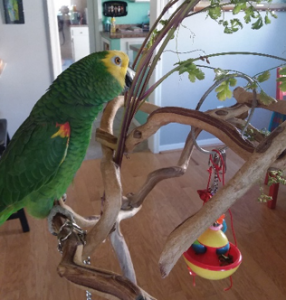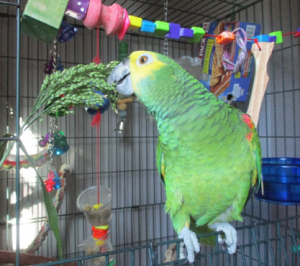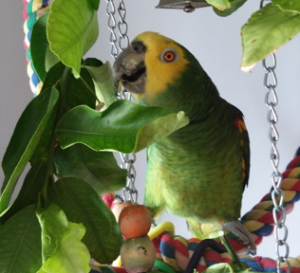Keeping our pet birds happy and healthy should be a top priority and when we can combine the two, that’s when things can get really fun! Providing a healthy diet is one of the best ways that pet owners can prevent certain disorders and keep their birds in top shape. Foraging is a great way to stimulate a bird’s intelligent mind and keep them happy and occupied throughout the day. Combining the two can be an excellent way to allow your bird to thrive.
Although many people talk about foraging with pellets, Nutri-Berries, and snacks, another great thing birds can forage with is fresh foods and non-toxic plants. After all, in the wild, a bird must search for its food every day if it wants to eat. Part of this search for food means the bird needs to tear through some less edible components of plants to get to the more desirable food item they are searching for. This act of tearing apart plant parts may be missed with more traditional modes of foraging. Therefore, one fun way to provide another unique angle to foraging is to provide whole, healthy plants for birds to forage with.
The following are a few examples of safe plants for your birds that you can grow, harvest, and use for fresh foraging fun.
 Cilantro
Cilantro
Cilantro is an herb that is easily grown in many home gardens or even in small window boxes. The entire plant is edible though most people use the leaves in things like salads or salsa and the seeds (also known as coriander) in cooking. The plant also is a great source of antioxidants, vitamin C, beta-carotene (a precursor to vitamin A), several B vitamins, and potassium. Pet birds can be given the entire plant, whether it is young or mature with seeds and flowers, to play with.
Millet
 It’s easy to purchase millet from the pet store but what you will get there is just the dried stalk with seeds. If you plant millet seeds at home though then you can grow the plant yourself and once the seeds start to emerge you can pull the entire plant and give it to your bird. Some birds enjoy pulling the stemmy leaves off the plant before they get to the delicious seed snack inside. The plant does not need to be dried before giving it to your bird as it would be with what you purchase from the store. Rather you can give it to them when the seeds are still ripe and green. This food item has some important minerals like calcium, iron, and magnesium.
It’s easy to purchase millet from the pet store but what you will get there is just the dried stalk with seeds. If you plant millet seeds at home though then you can grow the plant yourself and once the seeds start to emerge you can pull the entire plant and give it to your bird. Some birds enjoy pulling the stemmy leaves off the plant before they get to the delicious seed snack inside. The plant does not need to be dried before giving it to your bird as it would be with what you purchase from the store. Rather you can give it to them when the seeds are still ripe and green. This food item has some important minerals like calcium, iron, and magnesium.
 Citrus Trees
Citrus Trees
 Those people who have access to citrus trees can give trimmings to their birds. Lemon, orange, grapefruit and lime trees are all safe for pet birds. They can chew the branches, stems, bark and leaves. The flowers are edible as well as the fruits. As long as a tree has not been treated with any herbicides or pesticides it can be safe. When given the chance to explore these, birds can find delight in ripping apart the leaves, chewing through the branches, and nibbling a tasty flower. Make sure to be cautious of those trees that have thorns though and consider clipping these off before giving branches to your bird.
Those people who have access to citrus trees can give trimmings to their birds. Lemon, orange, grapefruit and lime trees are all safe for pet birds. They can chew the branches, stems, bark and leaves. The flowers are edible as well as the fruits. As long as a tree has not been treated with any herbicides or pesticides it can be safe. When given the chance to explore these, birds can find delight in ripping apart the leaves, chewing through the branches, and nibbling a tasty flower. Make sure to be cautious of those trees that have thorns though and consider clipping these off before giving branches to your bird.
Broccoli
The part of the plant that most people like to eat is the flowerets and if you give the plant a little more time to grow in the garden or accidentally miss the harvesting time these will bloom into small edible flowers. Parrots can eat these as flowers or flowerets but also consider giving them the stalk. It has a great crunchy texture that can help satisfy a birds natural chewing desire. This plant is also another great source of vitamin C, vitamin K, and iron.
Others
There are many other healthy foods that we can grow at home and take from our gardens for our birds to forage with. Parsley, cauliflower, basil and sage are very common items found in our vegetable gardens where the entire plant is safe for pet birds. Other branches and leaves from trees that are safe for birds include apple, apricot, peach, pear, weeping willow and almond.
(Photo comment: Small birds love foraging too and providing fresh plants is a great way to stimulate this behavior)
Presentation
Consider weaving branches and stems of plants through the bars of a pet birds cage so they have something fun to explore while you are away for the day. Clipping plants to other toys, swings or ladders can also be engaging ways to get a bird interested in them. Additionally, consider going outdoors and foraging together! It can be lots of fun to interact with your bird picking through safe plants and doing what is a completely natural behavior for your bird in the wild. Of course, if you go outside together, make sure to be safe and take appropriate precautions to keep your bird from flying away or being injured by any predators.
Safety tips
There are a few safety tips pet bird owners should keep in mind when offering fresh plant items to their birds. First off, only take plants from places you know and that do not use herbicides or pesticides. Rinse of plants before giving them to your birds so that no contaminants from wild animals can be present on them. If a plant has sharp spines, cut these off. Lastly, understand that these are just fun and safe additions to a parrot’s diet and activities for the day but they should not be the only part of the diet. Providing a balanced, diet is essential to making sure you have a good base to provide a healthy life for your pet bird.






I was wondering what is safe to often to finches? Your article mainly mentions parrots. thanks
Hello Pam,
Thank you for your great question. We contacted Dr. Lamb for a reply. She says, “I give fresh foods to my finches and they LOVE to forage through them. All the items mentioned in the article are safe for finches, too, but I have noticed that my finches particularly enjoy cilantro, parsley, and the fresh millet. After they are done chewing on the leaves or seeds, I often see them taking stems and trying to put them in their nesting areas to sleep on.”
We then asked if there were any quantity limits for finches. Dr. Lamb says, “As for a quantity limit for the finches I would say the only thing that should be limited is the amount of millet. Owners could pick the smaller, less-mature millets for the finches so that they are not getting too much of this food item and then not selecting other parts of their diet. The millet pieces could be about 2 inches at longest to be appropriate. As for the greens, though, they can have unlimited amounts of those because they really don’t overdo it with eating those.”
I can not read the articles because the right side is blocked by the categories column. Any ideas?
Hello Carol,
Thank you for contacting us. I’m sorry you’re having trouble reading the articles. Our web master tells me that it sounds like the issue might be the browser you are using. If it is Internet Explorer, that is the problem. The website is best viewed using Chrome, Firefox, or Edge. I’m also able to see it on my iPhone, which uses Safari. I hope this helps!
I love the articles you put in this site! I know a lot about the diet and care of little birds we have in cages. Foraging is a very important part of a bird’s health. You mentioned many things to use as foraging foods. How about an article on foraging homeade toys? I take yarn and roll it up into a 2 inch ball and then I stick a couple of sunflower seeds, or pieces of Nutriberries or almonds, etc. in between the yarn threads . I let the treats stick out just a little bit. You could hang the yarn ball up or put it on a table and let your bird go at it!
Also, I grow lemon grass on the window sill and then let my parrotlet play in it and eat it. I wet it down and he gets a bath from it when he walks through it!
Yarn can easily become tangled around the bird’s legs, neck, toe nails, etc and cut off circulation causing serious injury or even death. That also does not take into account whether they ingest any and the potential from what might occur from that.
My African Grey screeches whenever I answer the phone, put on the TV or lock her in her cage. If I don’t lock her and forget to watch her, she chews through the framework of my kitchen cabinet. She’s 30 years old and this behavior developed when started wintering in Florida and my next door neighbor complained. If she’s on my shoulder she’s happy. I put her in the bedroom cage when she screeches in the Living room. She’s quiet. I bring her out and screetch. I’m 74. Had her since she was 16 weeks. In one week we’ll have grandkids to babysit. Not sure if she’ll screetch or be quiet.